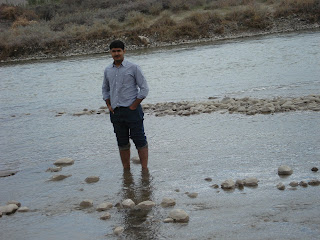17 May 07
The third day also began at 0930 hours and we headed to Khardungla Pass (43 Kms from Leh) which is 18,380 feet above sea level and is the highest motorable road in the world. Khardungla pass is on the way to Nubra valley, Partapur, Thoise and Siachan. The road till TCP (Traffic Control Post) was good but beyond that it is very narrow, mainly as the mountains are soft and full of sand. (Leh is also known to be ‘The Coldest Desert’). Mountains being comparatively young result in frequent land slide and damage the road. It is also due to Small Riverlet’s flowing over and across the road that the road needs frequent repairs which is undertaken relentlessly by our Border Roads Organization (Operation HIMANK). One can only visit these places till Partapur and that too with a valid permit beyond which, the civilians are not permitted. Although the roads were narrow but it was very beautiful as we were slowly and gradually moving on the serpentine roads with every hair pin bend taking us nearer to the clouds. There is no count of the mountains that we crossed. Looking back we could have a bird’s eye view of Leh and Shanti Stupa was the one that we could see from a very far of distance. After crossing the TCP we had another beautiful site which I will like to share with all, as we rarely get a chance to see another spectacle of nature.

(On the way to Khardungla)
(Above the clouds)
There was water flowing below the ice sheets on the mountains on the road side which appeared as if it is frozen water fall however when we stopped and had a closer view we found that beneath the snow the water was flowing, we caught this in our cam. We had an encounter with a beautiful animal called Murmut; it stays underground for nearly six month in a year and comes over ground only in so called summers of Ladakh.
(Playing with Ice at Khardungla)
(At the Highest Motorable Road in the world-18,380 ft)
The highest point, the Khardungla Pass had an army post and a temple. The temple is another 20 feet above, surrounded by snow, which we all climbed. One side of the road which gets a little or no sunshine was full of snow. We all took photographs and played with snow balls and ice sickles which are formed due to melting of ice. (Ice resembling Swords, formed by melting water which gets frozen again). We also took photographs of Fiber-reinforced Igloo type huts used by our brave soldiers from the Mighty Indian Army. After spending an hour we started back for Leh though we wanted to spend more time but chilly winds and low oxygen did not permit.

(Fiber huts( Igloo style) of the Indian Army)
On the way to Leh we stopped at Tsemo Monastery which was closed.
After reaching Leh we set course to Gurudwara Patthar Sahib via Air Force Station and along the river Indus. The Gurudwara is approximately 23 Kms from Leh on the Leh-Srinagar highway. On our way was the Highest bottling plant of LPG from Indane. We had packed lunch and hot tea after the darshan of the holy shrine and moved ahead to Magnetic Point.

(Gurudwara Patthar Sahib)
At Magnetic Point the vehicle parked in a specific place on the road starts moving on its own, against the gravity i.e up hill. Ahead of this was the Magnetic Hill, which it seem causes fluttering to even an aircraft flying over it, as it fall within the Landing Cone and all aircraft taking off and landing from/to Leh have to per force fly over this hill .
(Magnetic Hill, contains iron ore and attracts even aircrafts)
Ahead of this at approximately 4-5 Kms is the Sangam (Confluence) of river Indus (originating from China) and Zanskar (originating from Himachal), where one could clearly see the brown Zanskar water coming from China, mixing with green water of Indus flowing from Himachal and there after becoming Indus river.
(Sargam-Indus meets Zanskar)
On return to Leh we went to Leh Palace. Leh Palace rises from the edge of a hill overlooking the town and stretches out towards the indigo sky. A miniature version of the Potala in Lhasa, the Leh Palace is one of the major attractions in Ladakh. The palace was built in the 17th century and had nine storeys, but it is now dilapidated and deserted. It was the home of the royal family until they were exiled to Stok in the 1830s. Above the palace, at the top of the Namgyal hill, is the Victory Tower, built to commemorate Ladakh's victory over the Balti Kashmir armies in the early 16th century. This palace built for King Singge Namgyal, now houses the Ladakhi branch of the Indian Government's archaeological conservation organization.
(Leh Palace)
We then called it a day at about 1800hrs.













































